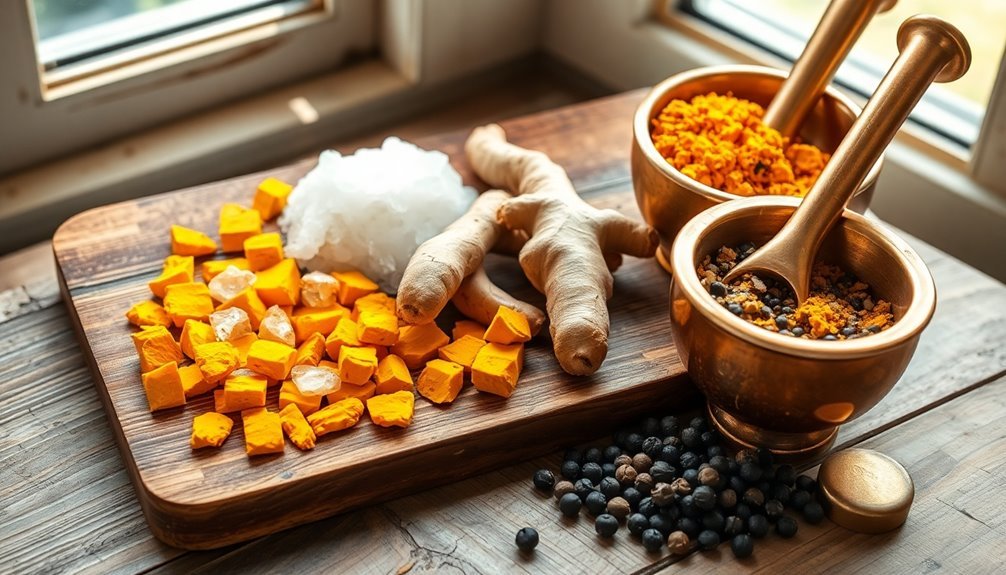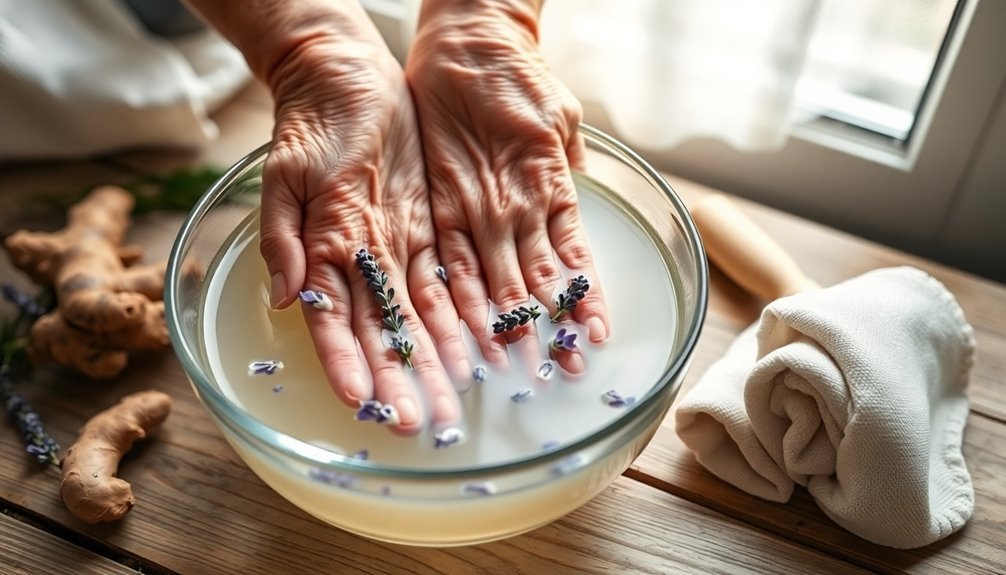You can effectively manage arthritis pain without drugs through five proven approaches. Start with natural anti-inflammatory solutions like turmeric, ginger, and willow bark to reduce joint inflammation. Apply heat therapy to increase blood flow and joint lubrication, or use cold therapy for acute flare-ups. Stay active with joint-friendly exercises like swimming or walking for at least 150 minutes weekly. Practice mind-body techniques such as mindfulness meditation or tai chi to break negative pain patterns. Consider alternative treatments like acupuncture or fish oil supplements for additional relief. These natural strategies offer powerful tools to help you take control of your arthritis symptoms.
Natural Anti-Inflammatory Solutions

For those seeking relief from arthritis pain without medication, natural anti-inflammatory solutions offer promising alternatives. Several herbs have proven particularly effective, with turmeric leading the way.
Turmeric blocks inflammatory compounds and helps reduce symptoms of both osteoarthritis and rheumatoid arthritis, especially when you take 500-1000mg of curcumin daily.
You can also try Boswellia serrata, which contains powerful boswellic acids that protect your cartilage while fighting inflammation. Studies show that Boswellia extract reduces osteoarthritis pain by nearly 20 points while improving joint function.
Ginger works similarly to NSAIDs, while willow bark provides natural pain relief through its active compound, salicin. If you’re dealing with gout, devil’s claw might help by lowering your uric acid levels.
Don’t overlook dietary supplements like Avocado Soybean Unsaponifiables (ASU), which can slow osteoarthritis progression by protecting your joints. You might want to combine glucosamine sulfate with omega-3 fatty acids for enhanced relief.
For topical treatment, try capsaicin cream – though it may cause initial discomfort, it provides lasting pain relief.
Remember to pair these natural solutions with anti-inflammatory foods and regular exercise for the best results.
Heat and Cold Applications
Managing arthritis pain effectively often requires a balanced approach between heat and cold therapy. Each treatment serves a unique purpose: heat increases blood flow and reduces stiffness, while cold decreases inflammation and swelling.
You’ll find heat therapy most beneficial for stiff joints and muscles, especially before exercise. Apply warm compresses, heating pads, or soak in a warm bath for 15-30 minutes. You can also try microwaveable rice pillows or heat patches for extended relief. Joint fluid production increases with heat application, helping to lubricate painful joints.
Just make certain the temperature is warm, not hot, to avoid burns.
Cold therapy works best during acute flare-ups when joints are swollen. Use ice packs, frozen vegetables, or cold gel packs wrapped in a towel for 10-20 minutes at a time.
Don’t apply ice directly to your skin, and stop if you experience discomfort.
For either method, you’ll need to take proper safety precautions. If you have heart disease, hypertension, diabetes, or deep vein thrombosis, consult your doctor before starting heat therapy.
Watch for skin reactions and always use a protective barrier between the temperature source and your skin.
Movement Through Physical Activity
While heat and cold therapies provide immediate relief, regular physical activity stands as one of the most powerful tools for long-term arthritis management.
You’ll find that staying active for at least 150 minutes per week can substantially reduce pain, improve joint mobility, and enhance your overall quality of life. The key is choosing joint-friendly activities that you enjoy, such as walking, swimming, or cycling. Exercise promotes relaxation and can significantly lower your baseline anxiety levels.
- Start with gentle range-of-motion exercises, which you can perform even when your joints feel stiff or swollen. These movements help maintain joint function and decrease discomfort throughout your day.
- Consider structured exercise programs, particularly water aerobics or tailored resistance training. These proven approaches can dramatically improve your symptoms and physical performance while being gentle on your joints.
- Break your activity into manageable chunks of about 30 minutes daily. You don’t need to do everything at once – even small amounts of movement provide meaningful benefits.
Mind-Body Healing Techniques
Your mind holds remarkable power to influence arthritis pain through established mind-body healing techniques. Through practices like Mindfulness-Based Stress Reduction (MBSR), you can learn to manage pain by breaking negative thought patterns and staying present in the moment without judgment. Research shows that MBSR can lead to reduced joint tenderness and morning stiffness in rheumatoid arthritis patients.
Breathing exercises and relaxation techniques offer proven relief for arthritis symptoms. You’ll find that biofeedback helps you control bodily functions by monitoring essential signs, while clinical hypnosis can effectively manage chronic rheumatic conditions.
These approaches are particularly valuable for addressing both physical discomfort and mental well-being.
You can explore holistic practices like Tai Chi and yoga, which the Arthritis Foundation recommends for pain management. These gentle movements, combined with mindfulness, improve balance and coordination while reducing pain.
Qi gong and sophrology offer additional options for combining physical movement with mental focus.
For emotional support, try Cognitive Behavioral Therapy to reshape destructive thought patterns. Guided imagery and looking at favorite photos can boost your mood and reduce anxiety.
With regular practice of these mind-body techniques, you’ll likely experience improvements in both your physical symptoms and overall wellness.
Alternative Therapeutic Treatments
Beyond mind-body techniques, alternative therapeutic treatments offer powerful drug-free options for arthritis relief. You’ll find several evidence-based approaches that can substantially reduce pain and improve joint function without medication.
Acupuncture has shown promising results, as the strategic placement of fine needles can stimulate your body’s natural pain-fighting responses and provide relief from arthritis symptoms. Regular sessions with qualified practitioners can provide long-term pain relief through targeted treatments.
- Consider trying glucosamine and chondroitin supplements, particularly if you’re dealing with knee osteoarthritis. While research results vary, these supplements have helped many people achieve moderate pain relief and improved joint function.
- Don’t overlook the benefits of fish oil supplements, which can help reduce inflammation and ease arthritis symptoms. The omega-3 fatty acids in fish oil have demonstrated potential in managing various types of arthritis.
- Look into orthoses and custom insoles, which can make a considerable difference in how your joints feel. These specially designed supports redistribute pressure on your joints and can provide substantial relief, especially for foot and knee arthritis.
Remember to consult with healthcare professionals before starting any alternative treatments, as they’ll help confirm these approaches align with your specific arthritis condition and overall health needs.
Frequently Asked Questions
How Long Should I Wait Between Using Heat and Cold Therapy?
You should wait at least 20 minutes between heat and cold therapy sessions. If you’re alternating treatments throughout the day, you can extend the waiting period to a couple of hours for best results.
Can Wearing Copper Bracelets Actually Help Reduce Arthritis Pain?
No, copper bracelets won’t help your arthritis pain. Scientific studies show they’re no more effective than placebos. You should focus on proven treatments and work with your doctor for proper arthritis management.
Are There Specific Foods That Can Trigger Arthritis Flare-Ups?
Yes, you’ll want to avoid processed meats, red meats, foods high in AGEs, refined carbs, and inflammatory fats. Nightshade vegetables, excessive salt, alcohol, and gluten can also trigger arthritis flare-ups in some people.
Does Weather Really Affect Arthritis Pain, or Is It Just Myth?
Yes, weather does affect your arthritis pain – it’s not a myth. Research shows humidity, air pressure, and wind speed can impact your symptoms. You’re not imagining it when your joints ache during weather changes.
How Often Should Arthritis Patients Replace Their Supportive Footwear?
You’ll need to replace your supportive shoes every 8-12 months for daily wear, or when you notice signs of wear. If you’re using orthopedic shoes, replace them every 1-3 years with checks every 6 months.
In Summary
You’ve got multiple natural options to manage your arthritis pain without relying on medications. Whether you’re applying heat and cold therapy, staying active with gentle exercises, or trying mind-body techniques, these drug-free approaches can help reduce inflammation and discomfort. Don’t hesitate to combine these methods or explore alternative treatments like acupuncture. Remember, you’re taking control of your health by choosing natural solutions for arthritis relief.





Leave a Reply